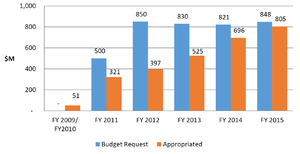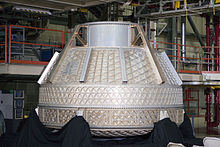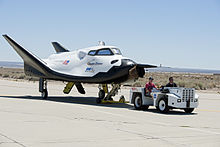Crew members (STS-131) on the International Space Station (14 April 2012).
Psychological and sociological effects of space flight are important to understanding how to successfully achieve the goals of long-duration expeditionary missions. Although robotic spacecraft have landed on Mars, plans have also been discussed for a human expedition, perhaps in the 2030s, or as early as 2021 for a return mission, or even in 2018 for a 501-day flyby mission for a crew of two with no landing on Mars.
A Mars return expedition may last two to three years and may involve a crew of four to seven people, although shorter flyby missions of approximately one and half years with only two people have been proposed, as well as one-way missions that include landing on Mars with no return trip planned. Although there are a number of technological and physiological issues involved with such a mission that remain to be worked out, there are also a number of behavioral
issues affecting the crew that are being addressed before launching
such missions. In preparing for such an expedition, important
psychological, interpersonal and psychiatric issues occurring in human
spaceflight missions are under study by national space agencies and others.
In October 2015, the NASA Office of Inspector General issued a health hazards report related to human spaceflight, including a human mission to Mars.
Psychosocial issues on-orbit
Researchers have conducted two NASA-funded international studies of psychological and interpersonal issues during on-orbit missions to the Mir and the International Space Station. Both crew members and mission control personnel were studied. The Mir sample involved 13 astronauts and cosmonauts and 58 American and Russian
mission control personnel. The corresponding numbers in the ISS study
were 17 space travelers and 128 people on Earth. Subjects completed a
weekly questionnaire that included items from a number of valid and
reliable measures that assessed mood and group dynamics. Both studies
had similar findings. There was significant evidence for the
displacement of tension and negative emotions from the crew members to
mission control personnel. The support role of the commander was
significantly and positively related to group cohesion among crew
members, and both the task and support roles of the team leader were
significantly related to cohesion among people in mission control. Crew
members scored higher in cultural sophistication than mission control
personnel. Russians reported greater language flexibility than
Americans. Americans scored higher on a measure of work pressure than
Russians, but Russians reported higher levels of tension on the ISS than
Americans. There were no significant changes in levels of emotion and
group interpersonal climate over time. Specifically, there was no
evidence for a general worsening of mood and cohesion after the halfway
point of the missions, an occurrence some have called the 3rd quarter phenomenon.
Much
has been learned from experiences on the International Space Station
about important psychological, interpersonal and psychiatric issues that
affect people working on-orbit. This information should be
incorporated in the planning for future expeditionary missions to a
near-Earth asteroid or to Mars.
Other psychosocial studies involving astronauts and cosmonauts have
been conducted. In one, an analysis of speech patterns as well as subjective attitudes and personal values
were measured in both on-orbit space crews and people working in space
analog environments. The researchers found that, over time, these
isolated groups showed decreases in the scope and content of their
communications and a filtering in what they said to outside personnel,
which was termed psychological closing. Crew members interacted less
with some mission control personnel than others, perceiving them as
opponents. This tendency of some crew members to become more egocentric was called autonomization. They also found that crew members became more cohesive by spending time together (for example, joint birthday celebrations), and that the presence of subgroups and outliers (e.g., scapegoats) negatively affected group cohesion.
In a study of 12 ISS cosmonauts, researchers reported that personal
values generally remained stable, with those related to the fulfillment
of professional activities and good social relationships being rated
most highly.
Another study examined potentially disruptive cultural issues
affecting space missions in a survey of 75 astronauts and cosmonauts and
106 mission control personnel. The subjects rated coordination
difficulties between the different space organizations involved with the missions as the biggest problem. Other problems included communication misunderstandings and differences in work management styles.
In a study of 11 cosmonauts regarding their opinions of possible
psychological and interpersonal problems that might occur during a Mars
expedition, researchers found several factors to be rated highly:
isolation and monotony, distance-related communication delays with the
Earth, leadership issues, differences in space agency management styles,
and cultural misunderstandings within international crews.
In a survey of 576 employees of the European Space Agency
(ESA), a link was found between cultural diversity and the ability of
people to interact with one another. Especially important were factors
related to leadership and decision-making.
Another study looked at content analysis of personal journals
from ten ISS astronauts that were oriented around a number of issues
that had behavioral implications. Findings included that 88% of the
entries dealt with the following categories: Work, Outside
Communications, Adjustment, Group Interaction, Recreation/Leisure,
Equipment, Events, Organization/Management, Sleep, and Food. In
general, the crew members reported that their life in space was not as
difficult as they expected prior to launch, despite a 20% increase in
interpersonal problems during the second half of the missions. It was
recommended that future crew members be allowed to control their
individual schedules as much as possible.
On-orbit and post-spaceflight psychiatric issues
A number of psychiatric problems have been reported during on-orbit space missions. Most common are adjustment reactions to the novelty of being in space, with symptoms generally including transient anxiety or depression. Psychosomatic
reactions also have occurred, where anxiety and other emotional states
are experienced physically as somatic symptoms. Problems related to
major mood and thought disorders (e.g., manic-depression, schizophrenia)
have not been reported during space missions. This likely is due to
the fact that crew members have been screened psychiatrically for
constitutional predispositions to these conditions before launch, so the
likelihood of these illnesses developing on-orbit is low.
Post-mission personality changes and emotional problems have
affected some returning space travelers. These have included anxiety,
depression, alcohol abuse, and marital readjustment difficulties that in
some cases have necessitated the use of psychotherapy and psychoactive medications.
Some astronauts have had difficulties adjusting to the resultant fame
and media demands that followed their missions, and similar problems are
likely to occur in the future following high-profile expeditions, such
as a trip to Mars.
Asthenization, a syndrome that includes fatigue, irritability, emotional lability, attention and concentration difficulties, and appetite and sleep problems, has been reported to commonly occur in cosmonauts by Russian flight surgeons. It has been observed to evolve in clearly defined stages. It is conceptualized as an adjustment reaction to being in space that is different from neurasthenia, a related neurotic condition seen on Earth.
The validity of asthenization has been questioned by some in the West, in part because classical neurasthenia is not currently
recognized in the American psychiatric nomenclature, whereas the
illness is accepted in Russia and China. Retrospective analysis of the
data from the Soviet Space Biology and Medicine III Mir Space Station study
has shown that the findings did not support the presence of the
asthenization syndrome when crew member on-orbit scores were compared
with those from a prototype of asthenization developed by Russian space
experts.
Positive outcomes
Isolated and confined environments may also produce positive experiences.
A survey of 39 astronauts and cosmonauts found that all of the
respondents reported positive changes as a result of flying in space.
One particular measure stood out: Perceptions of Earth in general were
highly positive, while gaining a stronger appreciation of the Earth’s
beauty had the highest mean change score.
Since the early 1990s, research began on the salutogenic (or growth-enhancing) aspects of space travel. One study analyzed the published memoirs of 125 space travelers.
After returning from space, the subjects reported higher levels on
categories of Universalism (i.e., greater appreciation for other people
and nature), Spirituality, and Power. Russian space travelers scored
higher in Achievement and Universalism and lower in Enjoyment than
Americans. Overall, these results suggest that traveling in space is a
positive and growth-enhancing experience for many of its individual
participants.
From low-Earth orbit to expeditions across the inner Solar System
Research to date into human psychological and sociological effects based on on-orbit near-Earth experiences may have limited generalizability to a long-distance, multi-year space expedition, such as a mission to a near-Earth asteroid (which currently is being considered by NASA) or to Mars.
In the case of Mars, new stressors will be introduced due to the great
distances involved in journeying to the Red Planet. For example, the
crew members will be relatively autonomous from terrestrial mission control
and will need to plan their work and deal with problems on their own.
They are expected to experience significant isolation as the Earth
becomes an insignificant bluish-green dot in the heavens, the so-called
Earth-out-of-view phenomenon.
From the surface of Mars, there will be two-way communication delays with family and friends back home of up to 44 minutes, as well as low-bandwidth communication channels, adding to the sense of isolation.
The Mars 500 Program
From June 2010 to November 2011, a unique ground-based space analog study took place that was called the Mars 500 Program.
Mars 500 was designed to simulate a 520-day round-trip expedition to
Mars, including periods of time where the crew functioned under high autonomy
conditions and experienced communication delays with outside monitoring
personnel in mission control. Six men were confined in a simulator
that was located at the Institute for Biomedical Problems in Moscow.
The lower floor consisted of living and laboratory modules for the
international crew, and the upper floor contained a mock-up of the Mars
surface on which the crew conducted simulated geological and other planetary activities.
During a 105-day pilot study in 2009 that preceded this mission,
the mood and group interactions of a six-man Russian-European crew, as
well as the relationships of this crew with outside mission control
personnel, were studied. The study found that high work autonomy
(where the crew members planned their own schedules) was well received
by the crews, mission goals were accomplished, and there were no adverse
effects,
which echoed positive autonomy findings in other space analog settings.
During the high autonomy period, crew member mood and self-direction
were reported as being improved, but mission control personnel reported
more anxiety and work role confusion. Despite scoring lower in work
pressure overall, the Russian crew members reported a greater rise in
work pressure from low to high autonomy than the European participants.
Several psychosocial studies were conducted during the actual
520-day mission. There were changes in crew member time perception,
evidence for the displacement of crew tension to mission control, and
decreases in crew member needs and requests during high autonomy, which
suggested that they had adapted to this condition.
The crew exhibited increased homogeneity in values and more reluctance
to express negative interpersonal feelings over time, which suggested a
tendency toward "groupthink".
Additionally, the crew members experienced increased feelings of
loneliness and perceived lower support from colleagues over time, which
had a negative effect on cognitive adaptation.
A number of individual differences in terms of sleep pattern, mood, and
conflicts with mission control were found and reported using techniques
such as wrist actigraphy, the psychomotor vigilance test, and various subjective measures.
A general decrease in group collective time from the outbound phase to
the return phase of the simulated flight to Mars was identified. This
was accomplished by the evaluation of fixed video recordings of crew
behavior during breakfasts through variations in personal actions,
visual interactions, and facial expressions.
Psychosocial and psychiatric issues during an expedition to Mars
There are a number of psychosocial and psychiatric issues that may affect crew members during an expeditionary mission to Mars. In terms of selection,
only a subset of all astronaut candidates will be willing to be away
from family and friends for the two- to three-year mission, so the pool
of possible crew members will be restricted and possibly skewed
psychologically in ways that cannot be foreseen.
Little is known about the physical and psychological effect of
long-duration microgravity and the high radiation that occurs in deep
space. In addition, on Mars the crew members will be subjected to a
gravity field that is only 38 percent of Earth gravity, and the effect
of this situation on their physical and emotional well-being is unknown.
Given the long distances involved, the crew must function autonomously
and develop their own work schedules and solve operational emergencies
themselves. They must also be able to deal with medical and psychiatric
emergencies, such as physical trauma due to accidents as well as suicidal or psychotic thinking due to stress and depression. Basic life support and staples such as water and fuel will need to be provided from resources on Mars and its atmosphere.
There will be a great deal of leisure time (especially during the
outbound and return phases of the mission), and occupying it
meaningfully and flexibly may be a challenge.
Furthermore, Kanas points out that during on-orbit or lunar
missions a number of interventions have been implemented successfully to
support crew member psychological well-being.
These have included family conferences in real time (i.e., with no
appreciable delays), frequent consultations with mission control, and
the sending of gifts and favorite foods on resupply ships to enhance
morale. Such actions have helped to provide stimulation and counter the
effects of isolation, loneliness, asthenization, and limited social
contact. But with the delays in crew-ground communication and the
inability to send needed resupplies in a timely manner due to the vast
distances between the habitats on Mars and Earth, the currently used
Earth-based support strategies will be seriously constrained, and new
strategies will be needed. Finally, since gazing at the Earth’s beauty has been rated as the major positive factor of being in space,
the experience of seeing the Earth as an insignificant dot in the
heavens may enhance the sense of isolation and produce increased
feelings of homesickness, depression and irritability. This may be
ameliorated by having a telescope on board with which to view the Earth,
thus helping the crew feel more connected with home.











